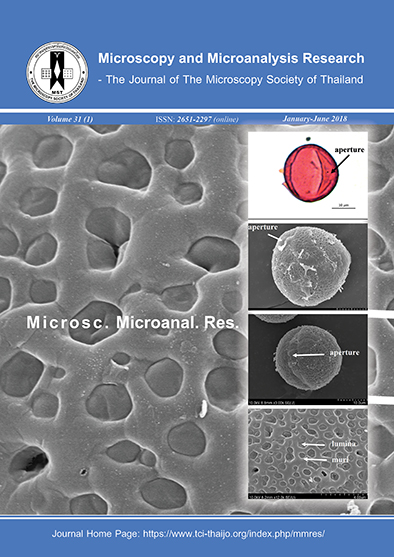Morphological and Functional Properties of Gluten-free Rice Spaghetti based on Rice Flour, Egg White Protein Powder and Soy Protein Isolate
Main Article Content
Abstract
The aim of this study was to determine the effect of egg white protein powder and soy protein isolate on the morphological and functional properties, and consumer acceptance of gluten-free rice spaghetti (GFRS). GFRS made from dry-milled high amylose rice flour (Chai Nat 1) which was blended with dry-milled waxy rice flour (RD6) at a ratio of 90:10 (w/w) with egg white protein powder (EWPP) varying at 0, 2.5, 5.0% db and soy protein isolate (SPI) varying at 0, 2.5, 5.0% db. The GFRS formulations were processed using a co-rotating twin-screw extruder up to 95 oC and then dried at 40 oC. The GFRS samples were analyzed by fluorescence microscopy, scanning electron microscopy (SEM), texture analyzer and sensory evaluation. Results showed that the fluorescence micrograph of the cross section of the GFRS containing 2.5% EWPP and 5.0% SPI (GFRS-E2.5S5) had a uniformly distributed protein network. SEM indicated that the surface of GFRS-E2.5S5 contained small pores of consistent size. The GFRS-E2.5S5 had the highest value of firmness and tensile strength, and the lowest stickiness. The consumer acceptance of the cooked GFRS samples was evaluated on the 9-point Hedonic scale. The result showed that GFRS-E2.5S5 had the highest score of overall acceptability (6.20) among all GFRS samples.
Article Details
References
2. M. M. Niewinski. Advances in celiac disease and gluten free diet. J Am Diet Nutr, 2008, 108, 661-672 (2008).
3. C. Marco and C. M. Rosell. Effect of different protein isolates and transglutaminase on rice flour properties. J. Food Eng, 2008, 84, 132-139.
4. P. Detchewa, M. Thongngam and O. Naivikul. Physicochemical and thermal properties of non-waxy rice flour as affected by waxy rice flour and its influence on textural and cooking properties of rice spaghetti. Int Proc Chem Biol Environ Eng, 2012, 39, 235-239 (2012).
5. Y. Mine. Recent advances in the understanding of egg white protein functionality. Trends Food Sci. Technol, 1995, 6, 225-232.
6. Y. L. Xiong. Structure-function relationships of muscle protein in food protein and their application. In: S. Damodaran and A. Paraf. Marcel Dekker, New York, 1997.
7. P. Detchewa and O. Naivikul. Effect of egg white protein powder on the textural properties, cooking qualities and sensory evaluation of gluten-free rice spaghetti. VRUResearch and Development Journal of Science and Technology, 2016, Vol 11 (2), 37-46.
8. P. Detchewa, M. Thongngam, J.L. Jane and O. Naivikul. Preparation of gluten-free rice spaghetti with soy protein isolate using twin-screw extrusion. J Food Sci Technol, 2016, 53(9), 3485-3494.
9. C. Zweifel, S. Handschin, F. Escher, B. Conde-Petit. Influence of high-temperature drying on structural and textural properties of durum wheat pasta. Cereal Chem, 2003, 80, 159-167.
10. J. L. Jane and J.-F. Chen. Effect of amylose molecular size and amylopectin branch chain length on paste properties of starch. Cereal Chem, 1992, Vol 69, 60-65.
11. AACC. Approved methods of analysis. 11th ed. Method 66-50.01. St. Paul, Minnesota 2010.
12. R.R. Matsuo, J.E. Dexter and B.L. Dronzek. Scanning electron microscopy study of spaghetti processing. Cereal Chem, 1978, 55, 744-753.
13. N. Wang, P.R. Bhirud, F.W.R. Sosulski and T. Tyler. Pasta-like product from pea flour by twin-screw extrusion. J Food Sci, 1999, 64, 671-678.
14. Altan, K.L. Maccathy, and M. Maskan. Effect of extrusion cooking on functional properties and in vitro starch digestibility of barley-based extrudates from fruit and vegetable by-products. J Food Sci, 2009, 74, E77-E86.
15. M.L. Sudha, K. Leelavathi. Effect of blends of dehydrated green pea flour and amaranth seed flour on the rheological, microstructure and pasta making quality. J Food Technol, 2000, 49, 713-720.
16. Y. Kim, J.I. Kee, S. Lee and S-H Yoo. Quality improvement of rice noodle restructured with rice protein isolate and transglutaminase. Food Chem, 2014, 145, 409-416.


